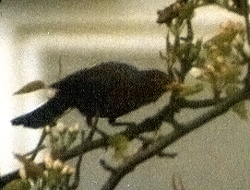Chinese Blackbird Turdus (merula) mandarinus

Photo © Nial Moores
First record: probably 4 individuals, July 14, 1999, near Sokcho, Gangwon Province. Subsequently recorded by Nial Moores on Daeheuksan, Jeollanam Province, on 30th April 2000; on Gageo Island, Jeollanam Province, on March 13th 2001; and 2 together on Eocheong Island, Jeollabuk Province, on 18th April 2002. In addition, several subsequent records from other observers, including apparently one at Seoul National University and one on Daeheuksan in March 2000.
Stopping by chance at an isolated rocky headland with an area of pine and other woodland, north of Sokcho City on July 14th 1999, Nial Moores immediately saw a Chinese Blackbird flying up off the track and into dense cover. Searching for the same individual, a singing male was located, and near to it, a nest, on which a female was sitting. Searching the area more thoroughly over the next hour probably two more individuals were observed, thought to be well-developed young of the year. On subsequent days, several other observers visited the area, videoing or photographing the birds (including Dr Park Jin-Young).
Identification was immediate as the Blackbird is one of the commonest and most familiar birds in northwest Europe, while Nial Moores also has experience of mandarinus from Hong Kong and from Japan. The mandarinus form, considered by several authorities to warrant full specific status and by others as a subspecies of merula (by e.g. the OBC), although similar to European Blackbird shows many significant differences, making sexing and ageing (and hence confirming breeding success at Sokcho in 1999) much more difficult.
The Chinese Blackbird is an overall blackish or dark brown thrush, with a yellow or yellowish bill, possibly at all ages. Differences from Common Blackbird Turdus merula of Europe (apparently the form incorrectly depicted in Lee, Koo and Park, 2000) include: (1) mandarinus is significantly larger-looking and more powerful; (2) the tail appears longer, and cleft, rather than fanned or rounded; (3) some males look scaly on the upperparts, rather than glossy; (4) and mandarinus apparently shows significantly reduced dimorphism. Both the singing males at Sokcho and on Eocheong Island in 2002 showed some brownish tones on the underparts and some paleness on the throat, indicative of females in western merula. In addition, mandarinus (5) shows a bare yellow patch in front of and also behind the eye; (6) seems to have a largely yellow or yellowish bill at all ages, rather broader at the base, and flatter-looking than the bill of merula; and (7) shows a variable amount of yellow on the legs, with typically yellow "knees". One or possibly two warmer toned browny-black birds at Sokcho showed all dark legs and some clear paler brown flecking on the head, indicative of a juvenile plumage. Merula has blackish or dark grey legs at all ages, and juveniles and first winter males show largely dark bills.
Although many thrush species (and individuals of those species) can show strikingly different dialects, (8) the vocalizations of mandarinus also are very different from those of merula known to the author. The song is rather harder and more desolate, and frequently contains repeated sequences, e.g. "Swee-swee-swee---Chit-Chit-Chit---seewoo-seewoo…" followed by harsh trills or chuckling. Typical calls include a long indrawn "Hu-Eeeek", and a harsh "Tek-Tek-Tek", much tinnier than the corresponding call given by merula.
Although ageing and sexing criteria of mandarinus are not well-known to Nial Moores, it appears that probably one adult male, one or two adult females and one or two juveniles were present at Sokcho. Subsequent records possibly involved a first year female or male on Deaheuksan (showing an obviously blacker head than the rest of the body); an adult male on Gageo; and an adult male and one unsexed individual on Eocheong Island.
According to published data from Japan and unpublished data from coastal Hebei Province, China (J. Hornskov in lit.) the Chinese Blackbird is being increasingly recorded in northeast Asia. The first accepted records in Japan according to Brazil (1991) were in March 1982, with 4 further records between then and 1990. Subsequently, they have proved to be almost regular in the Ryukyu Islands in winter. In Ishikawa Prefecture, Honshu (at about 36 degrees North), a female sat on unfertlised eggs in 1997 (in habitat very similar to that found in Sokcho, at about 38 degrees North). In Hebei, at 39 degrees North, they are now being recorded (near) annually in very small numbers, especially in May and October, with one singing bird even remaining into June in 2002 (Hornskov in lit.). In addition, Hornskov also noted one in Qingdao in winter, further supporting evidence of range expansion.
Although shown by Lee, Koo and Park (2000) to be largely resident, breeding north only to about 34 degrees North, it has presumably undergone a significant breeding range extension, probably migrating northward through southwest Korea in March and April to breed (not rarely) at a more northerly latitude (even possibly in the northern part of the Korean peninsula?).



